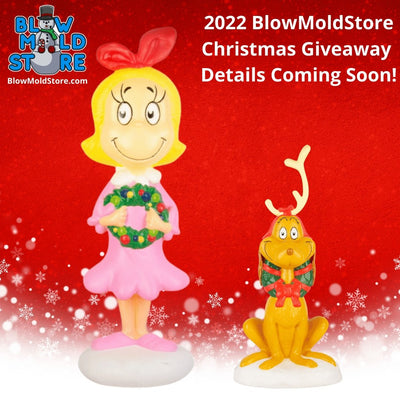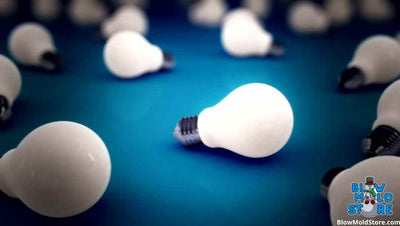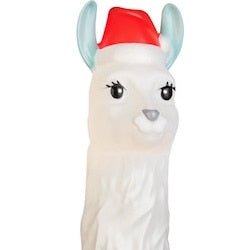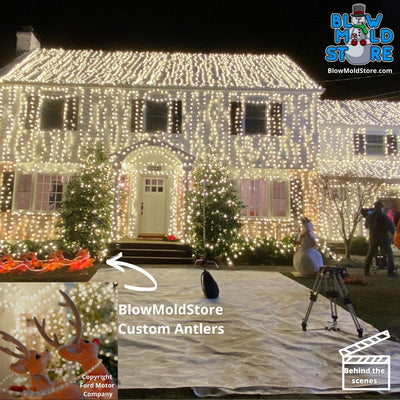
Mailbag Time! A Common question we get is regarding the best type of light bulb for blow molds. As there are many different blow molds, there may be many types of "best" light bulbs, especially depending on your taste. Here is an overview of what I've found works well for me, along with the common terms associated with the modern world of light bulbs.
Q: What bulbs are right for my blow molds?
A: There are many different opinions on what kind of bulb to use in which blow mold. We'll cover my preferences based on experience below. As long as you’re starting with the correct size bulb for the socket and you’re not exceeding the capacity of your cord and circuit, you mostly get to choose your bulb based on your taste and preference. For my money and sanity, I have fully converted to LED bulbs and love how I can put 300 blow molds on a single circuit due to the significant power savings with modern light bulbs.
Before we go any further though, let's cover a few important terms:
Lighting Measurements– Kelvin (K), Lumens, & Watts: Most folks are familiar with Watts for the strength or brightness of a light bulb, thanks to heat-generating incandescent bulbs. With modern LED bulbs, the more important numbers for brightness are now the Lumens and the Kelvin.
Lumens: This is the measurement of light output. It is like saying how strong the light source is. The higher the Lumens number, the brighter the light bulb will be.
Kelvin (K): This is the frequency of the light. This can contribute to the brightness effect, although more along the lines of the warm or cool appearance of the light.
Basic Lighting Overview:
I’ve found that high Kelvin (cool white) bulbs work great in snowmen, polar bears, and other mostly white blow molds. I enjoy low Kelvin (warm white) bulbs in blow molds with some paint color. I also make sure to use a lower Lumens bulb in white blow molds so they don’t wash out the rest of the display. Often a 3 - 5 watt LED (typically 25-watt equivalent, 200-350 lumens) bulb will work well in a smaller white polar bear or snowman, where I might want 800 or more lumens to light up those large, darker nativity camels. The bigger the blow mold, the more Lumens I’m typically looking for, with many medium sized blow molds being sufficiently illuminated by a 6-8 watt LED with output of 450-600 Lumens.
For the smaller sockets/bulbs, I’m almost always going with the same 1.5-watt 130 lumen C7 size bulb as I want the most I can get out of those typically undersized fixtures.
The prices of bulbs keep coming down, so it is getting more feasible to try out different Kelvin (color temperature) and Lumens (output) to see what works best for you.
Additional Blow Mold Lighting Terms to Know:Watts: This is how much power is consumed by the bulb. The lower the Kelvin, the softer and warmer the color temperature will be. The higher the Kelvin, the cooler white the light will be. Folks often like to have higher Kelvin bulbs in their predominantly white blow molds, and lower kelvin bulbs in the blow molds with color.
Equivalent Watts: This is when LED bulbs mention the overall strength and output replicated by a similar incandescent bulb. When an LED Bulb says it is 9 watts but 60-watt equivalent, it is the simplest way of saying you would see a similar strength light output from this 9 Watt LED as you would have from a traditional 60 Watt Incandescent. With an LED though, you use much less power.
Dimmable: With modern Christmas and other Holiday displays that use programmed switching and other types of light control, or for indoor settings such as dining rooms or areas with dimmer switches, dimmable bulbs are recommended. When a dimmer is engaged, it alters the way the power is delivered to the light bulb. Non-Dimmable bulbs don’t know how to handle that and simply fail to work. Dimmable bulbs are built to handle the variation and will change their intensity based on the dimmer settings.
Incandescent: Classic light bulbs that generally use 10x the energy vs the light they actually produce. Can generate significant heat and may require additional electrical circuits for displays of more than a few bulbs. Last only a few hundred to 1500 hours of use, fragile if dropped or mishandled.
LED: Newer light bulbs using modern technology to deliver more light using far less energy. Generates far less heat for the same light output vs incandescent bulbs, last much longer (10x – 40x longer) and typically not near as fragile or breakable.
E26 / Medium or Standard Base / A19 & A21: “Regular” light bulbs in the USA use the socket size of E26. These are also called Medium or Standard Base light bulbs. You may also see sizes of A19 or A21. These don’t refer to the socket itself, but to the shape of the bulb. For many years, A21 bulbs were the most common incandescent bulbs. Many LEDs are closer to A19 bulbs. Unless they’re side by side, it can be difficult to tell which is which. The most important piece of this is when you’re working with General Foam (GFP) flared light sockets, you will want to test fit the bulb and ensure it screws in far enough to light up. Squatty bulbs, which include some brands of newer LEDs like those made by FEIT the last couple years, won’t go in far enough. Also shorter A15 bulbs, while using the same E26 screw in socket, may not be tall enough for classic General Foam or other factory pieces.
E12 / Candelabra / C7: Smaller bulbs common in Blow Molds use the E12 or Candelabra size base. They’re commonly referred to as C7 bulbs, and that has to do with their shape and their diameter being 7/8” (the “7” in “C7” is how many 8ths). What is important about these bulbs is often the blow mold isn’t very large or deep, so while a taller and brighter candelabra bulb may fit, it may be dangerous, especially if you’re using an incandescent bulb. Taller bulbs may generate enough heat to melt part of the blow mold. Additionally, higher wattage incandescent candelabra bulbs may draw more wattage than your cord is rated to handle. Using newer and stronger LED bulbs will produce solid amounts of light without those same heat or wattage risks presented by classic incandescent bulbs.
The topic of lighting and light bulbs is vast so I'm sure we will dig in even further another time. Thanks for reading!









4 comments
I have vintage ghost blowmold I have a nite light bulb in it can I leave plugged all day and night?
I have vintage ghost blowmold I have a nite light bulb in it can I leave plugged all day and night?
I agree with the other post, links would be great. For example, I’m having trouble locating a 130-lumen, C7 bulb. Thanks in advance!
Hi. Love this article!! So helpful. I’m wondering if you can link the lightbulbs you use/recommend here? I’d like to buy the ones you’re talking about for the smaller blow molds and medium ones too. I’m also wondering if you can tell me a good blow mold light kit to buy as I have one small and one large blow mold that have no light/no cord/no way to attach the light. So I need a kit. Thanks very much and again thanks for this great article. I literally googled something like “what kind of lightbulbs should I use for Christmas blow molds and your site came up.